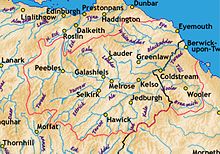River Tweed
The River Tweed, or Tweed Water (Template:Lang-gd, Template:Lang-sco), is a river 97 miles (156 km) long that flows east across the Border region in Scotland and northern England. Tweed (cloth) derives its name from its association with the River Tweed.[1] The Tweed is one of the great salmon rivers of Britain and the only river in England where an Environment Agency rod licence is not required for angling. Tweed is a British name of uncertain meaning.
Course

It flows primarily through the scenic Borders region of Scotland, and eastwards from the settlements on opposing banks of Birgham and Carham forms the historic boundary between Scotland and England. It rises in the Lowther Hills at Tweed's Well near where the Clyde, draining northwest, and the Annan draining south also rise. "Annan, Tweed and Clyde rise oot the ae hillside" is a saying from the Border region. East of Kelso, it becomes a section of the eastern part of the border. Entering England, its lower reaches are in Northumberland, where it enters the North Sea at Berwick-upon-Tweed.
Catchment
The river's valley floor is a drumlin field and the relic of a paleo-ice stream that flowed through the area during the last glaciation. Major towns through which the Tweed flows include Innerleithen, Peebles, Galashiels, Melrose, Kelso, Coldstream and Berwick-upon-Tweed, where it flows into the North Sea. Tweed tributaries include:
- Whiteadder Water
- River Till
- Eden Water
- Teviot Water
- Leader Water
- Gala Water
- Leithen Water
- Quair Water
- Eddleston Water
- Manor Water
- Lyne Water
- Holms Water
See also
- List of places in the Scottish Borders
- Tweeddale
- Anglo–Scottish border
- Union Bridge
- Rivers and Fisheries Trusts of Scotland
- Rivers of the United Kingdom
- Both sides the Tweed
Gallery
-
The River Tweed at Abbotsford, near Melrose
-
The River Tweed from Mertoun House, near St Boswells
-
The Anglo-Scottish border, with the Tweed on the east. Its estuary and the town of Berwick-upon-Tweed were a late annexation by England.
Notes
External links
- British Waterways: River Tweed
- The River Tweed Commission website
- The Tweed Foundation
- Tweed Forum website
- River Tweed: Special Area of Conservation (SAC)
- SEPA (Scottish Environment Protection Agency): River Level Data
- River Tweed map
- Gazetteer for Scotland: River Tweed
- Paper describing palaeo-icestream and landforms in the Tweed Valley
- Map and aerial photo sources for Tweed's Well and Tweedmouth
- Open Canoe Hire Specialists
- River Tweed
- Rivers of Northumberland
- Rivers of the Scottish Borders
- North Sea
- Anglo-Scottish border
- Sites of Special Scientific Interest in Annandale and Eskdale
- Sites of Special Scientific Interest in Berwickshire and Roxburgh
- Sites of Special Scientific Interest in Mid and East Lothian
- Sites of Special Scientific Interest in Tweeddale and Ettrick and Lauderdale
- Tweed catchment



